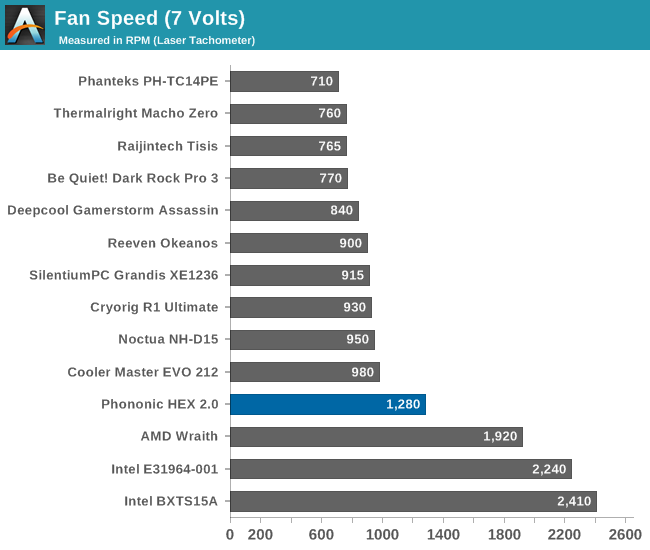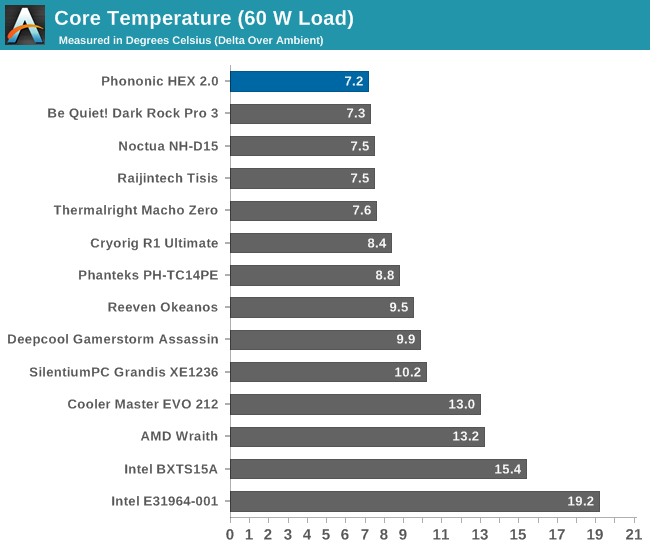The Phononic HEX 2.0 TEC CPU Cooler Review
by E. Fylladitakis on September 26, 2016 9:30 AM EST- Posted in
- Cases/Cooling/PSUs
- Cooler
- TEC
- Phononic
- HEX 2.0
Testing results, low fan speed (7 Volts)
Note that the voltage refers only to that of the fan, the TEC requires a constant 12V supply.


| Core Temperature, Constant Thermal Load (Low Fan Speed) |

The advantage of using a TEC at lower thermal loads becomes more apparent when the cooler fans are running at a reduced speed. Here we see that the performance of the HEX 2.0 was only slightly affected by the change of the fan’s speed under a thermal load of 60W, registering a thermal resistance of 0.1200 °C/W, a value comparable only to that of the best air coolers available. However, once again, the thermal performance of the HEX 2.0 degrades sharply as the thermal load increases, especially for thermal loads above 200W. With a thermal load of 340W, the thermal resistance of the HEX 2.0 is only 0.2506 °C/W, a very poor value that only outperforms low range and stock coolers.

In terms of acoustics performance, the 92 mm fan of the HEX 2.0 is virtually noiseless under these operating conditions. Our instruments recorded 33.6 dB(A) from a distance of one meter, only 3.2 dB(A) higher than our floor noise level. It will not be easily discernible by human ears inside a normal room, but it can be discerned if someone focus on the task.










48 Comments
View All Comments
MrSpadge - Tuesday, September 27, 2016 - link
Cooling at low power consumption levels (up to ~30 W) is very easy with modern coolers, unless you are restricting the hot air exchange with the environment (those HTPCs which for some reason have to be super small). If you're interested in such cases it would make more sense to test the case & envirnonment rather than the cooler itself.60 - 100 - 150 W covers typical CPUs under load very well, with 200 - 250 W representing overclocked socket 2011 chips and 340 W the extreme.
BurntMyBacon - Monday, September 26, 2016 - link
It would be interesting to see the crossover point between half on and full on. The aircooler isn't particularly large and doesn't seem to dissipate heat fast enough to keep up with the TEC. While providing a larger delta between the hot and cold plates, adding an extra 20W for the air cooler to deal with can, in some circumstances, actually increase the steady state temperature.A good test (that I'm not sure this kit would let you run) would be if you could test several TDP points at both half (20W) and full (40W) TEC power. I imagine you would see full power come in cooler up to the point that the air cooler starts failing to keep up. Switching to half TEC power would then be more efficient as it would dip back under that threshold. Once you increase thermal output to reach that threshold again, it would be interesting to see which mode works better with an overburdened air cooler. In the past, I've was told to use TECs with water cooling systems as air coolers at the time always got overburdened too early.
Avenger762 - Monday, September 26, 2016 - link
Once again, this thing is no match for my old CM V10. BTW the V10 in my tower has been running since 2006 with the exception of a couple of motherboard and fan replacements.VeauX - Monday, September 26, 2016 - link
it would be nice to see it compared to :1 - same size air cooler (comparable cu.cm or length / height / width)
2 - same price coolers including AIO Liquid Coolers
HomeworldFound - Monday, September 26, 2016 - link
I used to own a Thermaltake Subzero 4g Thermoelectric Cooler, used on a Pentium 4. This does seem like an evolved version of that. The Thermaltake used up a PCI slot and was oversized by 3/4 of an inch. There wasn't any condensation to deal with but I can't really say that it worked well.andychow - Monday, September 26, 2016 - link
Ask any physicist, and they will explain to you why thermoelectric cooling is a terrible idea. It's only if you need a specific solution, such as bellow ambient. Otherwise, it's super inefficient.powerarmour - Monday, September 26, 2016 - link
Yo dawg, I heard you need a cooler to cool your cooler?RaistlinZ - Monday, September 26, 2016 - link
I was interested in this until I saw the performance.Then I saw the price, and became even less interested.
benzosaurus - Monday, September 26, 2016 - link
In which we learn that "refrigeration" and "heat dissipation" are distinct and incompatible concepts.jlk440 - Monday, September 26, 2016 - link
Thanks for an interesting review. I'm puzzled by your reversal of the meaning of thermal resistance. Lower number = lower resistance = fewer degrees difference per watt of heat. For heatsinks, you want thermal resistance to be LOW, which means heat conductivity is HIGH. For some reason your terminology incorrectly calls lower resistance numbers "higher resistance", so maybe you mean higher conductivity (the opposite of resistance).